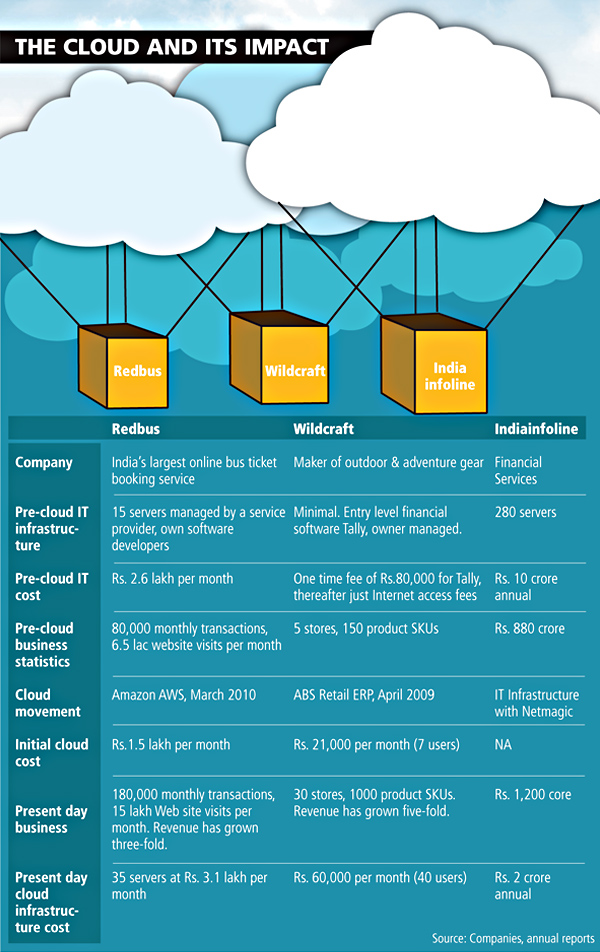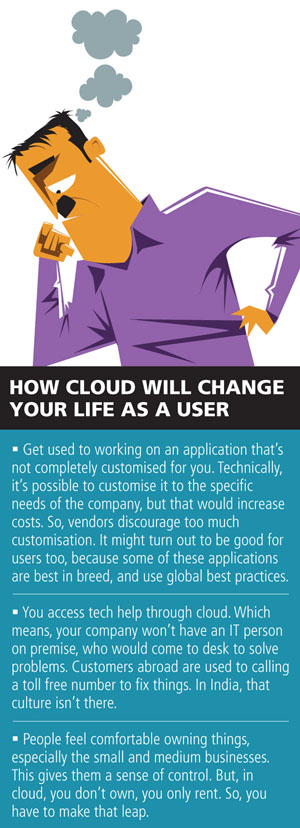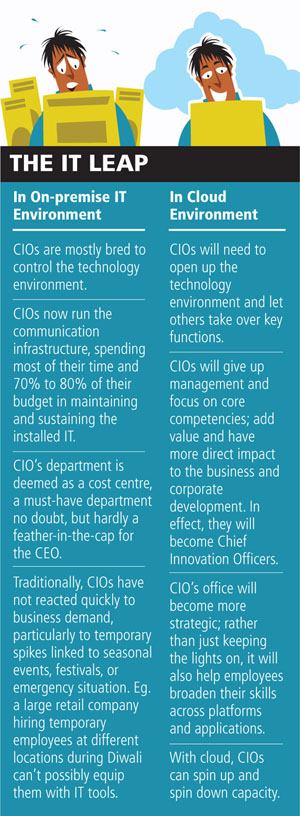
Forecast: A Clear, Cloudy Day In Cyber Space
Modern businesses need ways to stay nimble and light. Owning tonnes of hardware is not one of them. The time for cloud computing has arrived
There is this trick that Sankarson Bannerjee can show you. The chief information officer (CIO) of IndiaInfoline can show one of his 200-odd computers that run the trading platform of his company.
And then in the blink of an eye make one, two or even 10 of those computers disappear.
One moment, you can see those monster machines on a Web page, crunching and spitting out stock market data. The next moment there is nothing. The entire machine — even machines — disappears into nothingness.
And like Harry Potter, he can make them reappear as well. This is the way IndiaInfoline runs now. When the organisation needs an extra computer to handle the trading load, Bannerjee makes it appear and when it doesn’t, he makes it vanish.
Something About the Cloud
This might appear like a cheap trick till you find out that he has managed to reduce IndiaInfoline’s annual IT costs by a factor of five in a time span when the company’s revenues increased 36 percent. What’s more, his boys in the IT department are no longer procurement experts whose claim to fame is to know the ways of organisational bureaucracy. They are, if you allow for a little exaggeration, much like commodity traders. They scour for events when the need for computing power will surge and buy it just before the spike.
For instance, the day Coal India listed on the stock exchanges, the number of transactions done through IndiaInfoline jumped up 60 percent but the day was uneventful because Bannerjee’s boys had already “bought” extra computers in anticipation. And once the surge was over, all those computers were “extinguished” without incurring any further costs. Muralikrishna K., the head of Infosys’ Communications and Computers division, would empathise with Bannerjee. There are around 7,500 projects running on any given day at Infosys. Being a “software park”, the company was bound by rules that allowed it to procure hardware only when projects arrived, he says.
Today, using cloud computing technologies, Infosys can set up to 100 servers for a new project within 30 minutes. Back in its data centre, Muralikrishna can fit 800 “virtual servers” in the area of a 165-litre fridge. “New projects would take up to six weeks to start. Now we can do it in just 30 minutes,” he says.
This is just a glimpse of the potential cloud computing holds. So what is cloud computing? Cloud computing is when you can buy computing power the way you buy electricity. Today nobody manufactures their own electricity. Cloud computing promises to rid organisations of their need to buy physical hardware, expensive software and cumbersome storage. Organisations can buy the amount they need for a rental fee. If early signs are any indication, cloud computing holds the potential to allow rapid changes to their business model, deliver cost savings and change the way IT functions in organisations. Companies such as IndiaInfoline, Infosys, Tata Motors, ESPN-Star, Schiller Corp, and Mahindra Renault are using it to reduce either their IT hardware costs or software costs.
Build Up on the Horizon
Today, Google claims that “it has signed up over 2 million enterprise customers” on its Google Apps platform since launch, with about 100,000 enterprises (businesses, educational institutions and NGOs) in India alone. The arrival of companies like Salesforce.com and Microsoft could hasten that process with other big companies as their partners. Salesforce.com, which has 87,200 customers globally using 240,000 applications, says in India it has a variety of customers spread across small and medium businesses (SMB) and large enterprises such as Janalakshmi Financial Services, Bajaj Finance, Su-Kam and Tulip Telecom. Since Microsoft’s Azure launch in February in India, through professional developers and independent software vendors, it has managed 6,000 apps to be developed on this platform and 600 enterprises have adopted it. As the broadband and IT infrastructure becomes much more reliable, one expects to see the cloud gathering storm. Zinnov Consulting surveyed 100 Indian CIOs recently. The survey says that by 2015, 40 percent of respondents plan to spend at least 5 percent of the their IT budget on cloud and 21 percent expect to spend close to 10 percent of their IT budget on this new technology trend.
If there is one technology trend that will dominate the next five years, it will be cloud because this is what the Internet was truly supposed to do: To create a global computing grid, always-on, cheap and easy to use. It takes a while to appreciate cloud’s potential.
Why? Ok, name one area of spending where an organisation can add or decrease capacity at will. Actually there is none.
Office space has to be bought well in advance and with an assumption of future hires. You can’t get rid of half your office space if you don’t need it. Plant, machinery and even IT systems have to be bought in advance. Capital-raising has to be done mostly when you don’t need the money. Increasing or decreasing debt in favour of equity always needs forward planning and expensive investment bankers. Ok, you say “people”. Sure, people can be hired at will but only when the numbers are small and in today’s India only in theory, but still. Can you let them go once you realise you’ve hired a few extra? It is an unlikely scenario. That’s why cloud is so interesting. With cloud computing, IT costs can be adjusted on demand. “There is a taste test for cloud computing. You should be able to increase and decrease IT infrastructure and you should be able to pay for only what you use,” says Sharad Sanghi, CEO, Netmagic, one of the companies that offer cloud computing solutions.
According to Zinnov’s survey, over the next five years, more than 40 percent Indian companies will move email, enterprise software and customer relationship management software to the cloud. They have already started investing in buying computing power or virtual servers, just the way IndiaInfoline does. The paradoxical thing about the cloud is that it is small companies rather than the big companies that are investing in it. Since the big tech companies haven’t done what mobile companies like Airtel or FMCG companies like HUL have done, which is evolve business models to target the price-sensitive mass market, it has allowed a host of smaller technology firms like Netmagic, Sify, Nustreet, Affordable Business Solutions and even Amazon to move into this market.
That’s a big thing. Consider the big ticket IT investments that Indian companies have made in the last 15 years. It started with the enterprise resource planning software (ERP) wave in 1995 and Internet followed soon. The late 1990s saw the rise of customer relationship software, business intelligence software and by 2003 IT outsourcing (remember the Bharti-IBM deal?) was the game-changer. It was the big companies that were the first to buy such software offerings. Small- and medium-sized companies took to them a good three to five years after the big companies had done so.
Small Guys, Big Step
Since big companies were buying all this, there was little need for software companies to re-engineer their product for the smaller companies. This is one reason why Karnal Agro Forging could never invest in an ERP. Located in Karnal, a town of less than 1 million people, it isn’t really where the SAPs and the Oracles of the world would look for customers. Even if they had made a sales pitch, their costs would be too high for this 50-year-old company that makes metal parts for agricultural equipment. Then the third generation family businessman, 28-year-old Rohit Rajpal, took over as the executive director, manufacturing and IT, this year. Rajpal wanted to get the efficiency and process focus that ERP brings. And that’s when he discovered what S. Parthasarthy, founder CEO, NuStreet was selling.

Parthasarathy, who earlier founded Aztec Software, today wants to target the SMB sector, which isn’t well-served in terms of IT offerings. So, Chennai-based NuStreet builds applications for niches like spinning, forging, manufacturing and health care sectors, and hosts them on Microsoft infrastructure, reducing its own hardware cost. In a conventional software scenario, the cost of customisation and selling it to different market segments would have killed him. But because the application is in the cloud, he can use the basic kernel of the software, customise it a little bit and offer it to customers of different industries.
Rajpal now gets key business metrics in his email every day, for a monthly fee and no upfront investment. “Earlier, the production planning needed to be done 15-20 days in advance, now we can do it in a day,” says Rajpal, who now has all his 25 units in his Rs. 150-crore enterprise linked through the cloud. The company can now identify line rejections, which has led to 5-10 percent savings. Secondly, due to MIS (management information system) data, Rajpal is now able to find out where the raw material is getting blocked, which has led to 10 percent improvement in the cash flow. Moreover, due to the in built profitability meter in the application, he is able to compare his company’s performance against the industry average every month.
For many small- and medium-sized companies the big challenge is keeping their IT department staffed. “We’ve got clients whose entire IT departments have been wiped out in one shot from just one headhunter who comes calling,” says Srikant Rao, CEO of Affordable Business Solutions, a Bangalore-based company that develops customised cloud-based ERP solutions for SMEs.
This is bad news for a company like Wildcraft, a maker of travel and adventure gear. A self-funded company, Wildcraft was for many years wary of expanding its store network because the company was unsure how well it could manage its cash operations. It was also very conservative with the number of products it offered because it felt its inventory would get too unwieldy. But since adopting the cloud-based ERP in April 2009, the company has been able to scale up fast. Siddharth Sood, one of the company’s founder-directors, says, “It now takes me less than an hour to configure a new showroom.” Wildcraft has expanded its stores from five to 30, and products from 150 to 1,000 in 18 months, leading to a five-fold increase in sales.
Even for companies that are extremely savvy and venture-funded, the cloud offers the great advantage of speed. redBus is a five-year-old company that pioneered online sales of bus tickets and is today the leader in that field. It is much more technology-savvy than most companies its size. The founders are all engineers and ex-employees of IT companies.
Yet in March this year they migrated to Amazon’s cloud service lock, stock and barrel after learning the hard way how long it took to do things like add a new server or simply open an additional hardware port on one — two weeks and two days, respectively. Charan Padmaraju, its co-founder and CTO, says as a result, his developers spent hours chasing up with their data centre service provider for even minor things. The result was their hardware was either stressed out during spikes and under-utilised during average days.
“Last Diwali as the visitors to our Web site shot up, our servers slowed down before finally crashing. We were completely helpless and had no option but to restart everything. We must have lost a few lakh rupees because of that,” says CEO Phanindra Sama. In contrast, this Diwali, as customer visits increased by 100 percent, redBus simply ordered extra servers that were just “clicks away”, says Sama.
Today redBus buys computing on an hourly basis from Amazon. During the day it has 35 servers to handle the booking load. At night there are only 20 servers in existence. “We just de-commission other machines during the night,” says Sama.
Stability is an Exception; Volatility a Norm
The volatile nature of customer demand that redBus or IndiaInfoline experience, is a reality for many consumer-facing businesses today. This is also the reason why IT spending doesn’t yield the sort of payback that CIOs often present to their CEOs. In 2005, IndiaInfoline’s technology spending was about 4-5 percent of total sales. That’s a very normal level. Then as the bull market gathered momentum, trading volumes increased. Annual IT spends shot up to 7-8 percent of total sales. “It was considered okay because conventional wisdom had it that in three years you recover your money,” says Bannerjee. Then the downturn hit. Trading volumes dropped fast but more importantly, revenues dropped even faster. IT Investments made during that time did not yield payback. “Our business is not like steel where the demand cycle is 10-12 years. It is much, much shorter,” says Bannerjee.
So what does a company do when it can’t let go of office space or computers? It lets its people go to reduce costs and maintain profitability. With the cloud, since all these costs are truly adjustable, it means the investment is always recovered. “Plus, I always have the latest IT hardware running and the latest version of the software running,” says Bannerjee.
With the CIO’s ability to deliver business returns, his role in the organisation is all set to change (see graphic). That is best seen in the way other staff in the IT department functions. “Earlier our guys were all specification experts. They knew which Nehalem processor [to buy], how many ports in a computer, etc,” says Bannerjee. They were also experts in knowing when to order, what forms to be filled to get approvals. “Today we want people who can understand our business better. We want capacity planners,” he says. So his guys keep an eye out for the sort of things that can boost volumes, and to do that they need to understand the stock broking business better.
Big Guys; Bigger Worries
It isn’t as if large companies don’t see these changes. It is just that large organisations aren’t sure about wanting to see their data, their computers all in a virtual form. What if the Internet crashes? What if the data gets stolen?
 Consider the case of Welspun, a textile company. It uses a software to collect real time shop floor data directly from machines. The analysis of this data can reveal things like the top five reasons causing maximum rejection in the last 30 minutes, and this happens instantly. This software could cost 30 percent less if deployed in the cloud. But Welspun has opted for an in-between method. Its IT systems are leveraged by Covacsis, which has developed the software solution, for deployment. Through its own small private cloud, Covacsis provides customer support not only to Welspun but to other companies like Castrol India, Grasim and Godrej where it has deployed its software product.
Consider the case of Welspun, a textile company. It uses a software to collect real time shop floor data directly from machines. The analysis of this data can reveal things like the top five reasons causing maximum rejection in the last 30 minutes, and this happens instantly. This software could cost 30 percent less if deployed in the cloud. But Welspun has opted for an in-between method. Its IT systems are leveraged by Covacsis, which has developed the software solution, for deployment. Through its own small private cloud, Covacsis provides customer support not only to Welspun but to other companies like Castrol India, Grasim and Godrej where it has deployed its software product. “Culturally, we are a control-freak population, so initial apprehension for cloud is justifiable,” says Tarun Mishra, whose company Covacsis manages this facility for Welspun and others.
Take HDFC Bank. Over the next 12 months all that is moving to the cloud is the stuff that runs on the Windows platform. Its heavyweight software like core banking and ATM switches will remain inside its walled garden. “I think the cost advantages of the cloud are well understood but the sort of mission-critical software we use doesn’t take to the cloud as of now,” says Anil Jaggia, CIO of the bank.
Most banking software, or for that matter ATM software, is usually created around specific hardware for high performance. The performance of such software suffers severely when put on any other type of hardware. When you sign up for the cloud, it is hard to control the exact configuration of hardware. So HDFC Bank is planning to move its less critical applications on the cloud over the next year or so. “For the more critical applications, we will have to look at a longer time frame,” says Jaggia. A large company like HDFC Bank will need more assurances from its technology vendors before it does that.
“Big software makers aren’t very cloud friendly at the moment, says Rakesh Kumar, a vice president with research firm Gartner. Firms like SAP and Oracle are wary of introducing cloud-specific licensing models because they’re afraid that revenues will dip. As a result, when a company like HDFC Bank or Tata Steel wants to shift to the cloud, it finds its software costs largely unchanged. Many large companies also say that the quality commitments they get on cloud platforms aren’t good enough. That may be true but it is also true that large enterprises prefer to own hardware and software so as to claim tax (depreciation) benefits.
The biggest concern is around security. Companies have traditionally stored data on the hardware in their premises and secured them with firewalls, anti-virus software and a range of controls — physical and virtual. When the data moves to cloud there is a fear of data loss (for example, in October, Mint newspaper lost all the blog posts it had hosted on a cloud server), and indeed data theft. Besides, cloud does not offer customers the satisfaction of seeing data destruction. (No optical disk gets shredded, for example. When you use less data, the part of the machine that stored your data simply goes to someone else.) Another aspect closely tied to data is the fear of getting locked to a cloud provider. ‘Open Cloud Manifesto’, a document calling for open standards in cloud computing, so that customers can move data and applications from one cloud to another easily, seems to have enlisted support from a range of IT players — from IBM and Cisco to Jamcracker and Sybase. But the biggest names in cloud computing today — Amazon, Google, Microsoft and Salesforce.com — are missing from the coalition. Peeyush Ranjan, head of engineering, Google India, says the standards for cloud computing are coming up, with Google itself pushing for some. Peter Coffee, director Platform Research, Salesforce.com, says interpretability of clouds is essential but it “should be a combination of strengths, not a forced convergence of common subset of capabilities”, something that was the norm in the earlier PC era.
It’s easy to see why standards are not in place. Cloud computing is still in a nascent stage. It demands a fundamental shift in the way businesses have looked at IT. “We are living in a post-PC world,” says Amit Singh, who moved to Google as vice president, international sales and operations, enterprise business, after spending two decades at Oracle. He feels the move from PC to cloud is as significant as the move from Mainframe to PCs. Which also means that the companies which have invested in IT systems have to go through a huge transition.
 “For a large enterprise, with its applications customised extensively, and data residing in different places, the decision is not as easy as it is for a small firm with no legacy systems,” says Malcolm Frank, senior vice president, marketing and strategy at Cognizant Technology Solutions.
“For a large enterprise, with its applications customised extensively, and data residing in different places, the decision is not as easy as it is for a small firm with no legacy systems,” says Malcolm Frank, senior vice president, marketing and strategy at Cognizant Technology Solutions.If the existing legacy systems make it difficult for them to move, the grand promise of cloud computing is tempered by less than attractive service levels. Large companies have much more stringent quality norms than smaller companies and they find that the higher price they pay for such standards wipes out the cost advantage. Infosys’ Muralikrishna says the enterprise-level service levels that large companies seek also tend to be 25-30 percent more expensive than what vendors normally advertise or brag about. These are revealed often during protracted negotiations.
“It’s a mindset issue,” says Sridhar Vembu of Zoho Corp. Zoho, which has been focussing on the American markets for long, has now turned its attention to India. It’s realising that it needs more patience to penetrate this market. “In the US, there is a do-it-yourself ethos. If you provide online tools, they do most of the work. In India, it’s common to say, ‘can you do it for me?’ So, you apply more labour, more resources here. Invest more on sales and support. Here customers need more handholding.”
In many ways cloud computing is to technology what outsourcing was to global business. This shift, though inevitable, will upend many entities in the technology value chain — enterprise software vendors, hardware makers and internal IT teams. And new ones like Amazon, Salesforce.com, Sify or Netmagic will step up to fill in new roles.
Once companies like Indiafoline, Redbus or even Welspun use this technology trend to gain market share, it would be hard for peers to keep the cloud at bay. As Robert De Niro said in Cape Fear “You can run, but you can’t hide!”
(Additional reporting by N.S. Ramnath & Shishir Prasad)
IS CLOUD COMPUTING FOR YOU?
by Philip Mckinney
Not every small business needs to operate “in the cloud”. Before you make the move, consider these five criteria, care of Philip McKinney, vice president and chief technology officer of Hewlett-Packard’s Personal Systems Group.
How Fast Is Your Business Growing?
Investments in hardware and software typically follow a stair-step pattern. Incremental outlays often lead to too much capacity. Cloud computing can more smoothly match technology expenditures with a company’s natural trajectory. Fast-growers tend to be good candidates for the cloud, as are those with choppy or seasonal demand.
Where Are The Troops?
Cloud services, by definition, are available 24-7. That gives employees and customers access to information from anywhere and in real time — a huge advantage for companies with operations in different locations and in multiple time zones. The more spread out a business is, the more the cloud can help.
How Reliable Must Your System Be?
A system boasting 99.999 percent availability means that it will be offline just 6.05 seconds per week, while one offering mere 99 percent availability will be down 1.68 hours per week. Those three extra 9s don’t come cheap — perhaps eight to ten times more than cut-rate 99 percent service — so be honest about how much uptime your system must deliver to meet your customers’ needs. (If you’re not in the health care, telecommunication or public safety industries, 99.95 percent should do.) Also keep in mind that overall reliability depends not just on the cloud vendor but also on the network provider. Beware: Neither cloud vendors nor broadband providers will race to take ownership of your
system’s reliability.
Is the Service Secure Enough?
Some cloud vendors share their servers with other customers—that may not be a good fit for companies in regulated industries, such as health care and banking, as data are never 100 percent secure in a shared environment.
Good Track Record?
There now are hundreds of cloud vendors to choose from. Many are launching new services, like mobile marketing and social networking, to separate themselves from the pack. But lots of new players and incessant innovation also invite instability, and cloud vendors go out of business for all sorts of reasons. Vet them by scanning sites like cloud fail.net, which tracks data on outages and reliability for popular cloud services. And if anyone is dissatisfied, chances are they’re barking about it on Twitter.
(This story appears in the 17 December, 2010 issue of Forbes India. To visit our Archives, click here.)
-
 Abhijit Anand Prabhudan
Abhijit Anand PrabhudanLooking at wikileaks recent experience with amazon cloud, every organization has to implement cloud deployment strategy with caution. It seems that 'hybrid cloud' approach will be followed by most. Also organizations will have to put into place 'cloud insurance' policies!!, relying on just one vendor is not wise.
on Dec 13, 2010
















